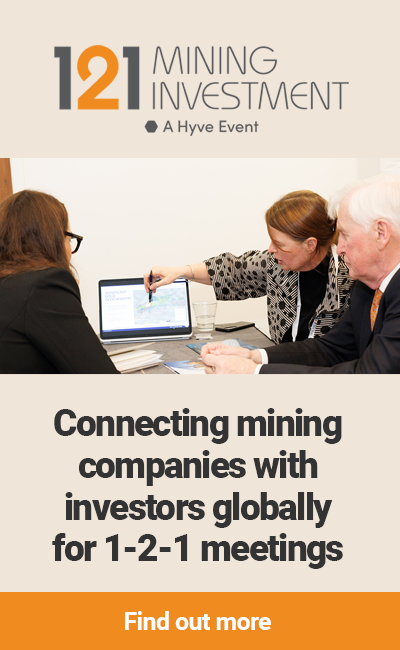Chris Berry has been an independent analyst since 2009 with a focus on Energy Metals supply chains including lithium, cobalt, graphite, vanadium, and rare earths.
His advisory work provides strategic insights to asset managers, banks, and corporates and has a specific focus on how disruptive trends in energy, strategic metals, and technology create opportunities. Before shifting focus to analysis of these trends, Chris gained twelve years of capital markets experience on both the buy side and sell side.
He has visited metals deposits on five continents and has been featured in the Financial Times, the Wall Street Journal, CNN International, and other media outlets providing insights around raw material supply chain dynamics.
I wanted to go through what you’re seeing in the battery metal space during these interesting, extraordinary and hopefully once in a generation times we’re experiencing.
I think that it is once in a lifetime, as you mentioned. Once in a hundred years, whatever the phrase you want to use, I mean, none of us in this space have ever seen anything like this. You’ve got this interesting situation where the demand for battery minerals and its supply chain is growing at double digit rates, and that’s all exciting and we’ve all banked on that going forward. Then suddenly, out of left field comes this pandemic and basically the entire economy, not just the lithium ion supply chain, is completely frozen, so I think that it’s really tough to now think about what’s going to happen in 2020, when we’re all trying to figure out what’s going to happen tomorrow, next week or even next month.
To cut right to the point, you can take your forecasts for 2020 and just throw them out the window and start over. My view is that, with respect to the battery minerals space – that’s lithium, cobalt, graphite, copper, nickel and some of the larger bulk metals, you probably aren’t going to see much of a pricing recovery or an upturn until probably mid to late-2021. At this point in time, I just think there’s so much indecision in the market. I don’t think that this EV revolution will be denied by any stretch of the imagination, but it’s certainly delayed and probably delayed for at least another 12 to 18, and perhaps maybe even 24 months, if we’re unlucky.
So you’re thinking that this is more of a temporary pause in EV development?
I’d say it’s a bump in the road. Obviously it’s a big bump. Anytime you have to throw away forecasts and rethink the framework around investing, which is what we should all be doing, it’s a serious issue. I do think that supply chains in particular are going to have to get more flexible and more robust coming out of this, and I think ultimately that’s going to be a pretty positive takeaway where we look back on this in five or 10 years.
There’s a 20-year view of what miners should be doing, particularly in the nickel space. What are your thoughts on that?
Yeah, I think it’s investors. Typical investors obviously don’t have a 20-year view. And that’s where the strategic players come in and you’ll see EV penetration increasing relative to internal combustion engine penetration over the next few years, a decade, I should say.
What should the miners be doing? Obviously now it’s all about cash conservation. We’ve seen Glencore reign things back in Zambia. This morning, there was a lithium project in Argentina that’s now mothballed. I think you’re going to see a lot more of that going forward unfortunately, partially because the economics just don’t dictate that some of these projects are going to be able to progress. Despite all this, again, the demand for battery minerals continues to grow quite strongly. So what should the miners do? I hate to say this, because it’s not particularly actionable, but reign in the spending, be very strategic and focused about how you spend capital that you have. This is just something that we’re going to have to wait out.
And what is your view looking into mid-2021? What will that recovery look like?
We’ll have a lot more clarity around regulatory issues with respect to EV adoption and penetration. And of course, stimulus. You’ve got upwards of US $11-$12 trillion of stimulus that’s being pumped into the global economy right now, or at least, that has been announced it’s going to be pumped into the global economy. Within a year, obviously that liquidity presumably will have taken hold and will have generated some semblance of economic growth. So you want to see how the stimulus is rolled out both inside and outside of China, number one, and then also, just the regulation in general. I think that how China in particular, or even the European Union uses a mixture of carrots and sticks to incentivize EV adoption is going to be very important. I think you’ll see some changes there.
Ultimately, the big tell for me would be, and has always been, looking at battery costs in terms of dollars per kilowatt an hour, when you see that start to level off, or God forbid turn up, then you know there is a problem. But that phenomenon, that cost deflation, that I always watch in the battery space just hasn’t happened and it doesn’t look like it’s going to happen anytime soon. Therefore, keeping an eye on some metrics around stimulus and of course the trajectory of battery costs is really important right now.
Last year we had rare earths being interjected into the US-China relationship, and with the trade war still going on, how do you see rare earths? Is the US still going to be interested in the technological and supply chain decoupling from China even after this?
I think so, regardless of what happens in November 2020 with the election. I think that if Donald Trump has done anything, and he’s obviously a divisive figure, he has put this economic relationship between the US and China, right at center stage. I think that will continue going forward after we’ve passed through the worst of COVID-19, and of course, after the trade war presumably gets resolved. Nevertheless, rare earths are a strategic mineral, whether you’re Chinese, American, European, or what have you. Coming back to what I alluded to earlier, I think that strategic minerals, like rare earths, lithium and cobalt are going to be a centerpiece of reconfigured supply chains going forward.
I’m sitting here in Washington DC this morning, there is a move with rare earths that is clearly on the radar. Whether or not you talk to the Department of Commerce, Defense or Energy, there is an awareness of the dependency of these critical minerals. It’s an interesting time because you’ve got a pandemic, a trade war, and a presidential election coming up, and we’re all trying to figure out where this new idea around supply chains fits. If there is a major takeaway from everything that’s happening, it’s going to be that supply chains are going to become more regionalized and perhaps smaller and more robust because of it.
Moving on from rare earths, let’s focus on some other metals and let’s start off with cobalt.
Cobalt is interesting. If we were having this conversation in 2015 or 2016, I would have been pounding the table, outrageously bullish, very excited about it for all of the reasons, with its critical nature in batteries, and so on and so forth. It’s probably, of all of the battery metals, the one that I find the most interesting, because it really does have this geopolitical and socio-economic element to it. The economics to a certain degree, will always be dictated by this because the majority of cobalt comes from the DRC. This is a problem if you’re VW or Tesla or any automaker for that matter, because you’re trying to burnish your green ESG credentials right now. Who wants to be linked with artisanal or child mining in the DRC, when you’re trying to say, “Look at how clean and green we are.”t
I think the issue with cobalt right now is that you’ve literally got every battery scientist known to man, trying to figure out how to engineer cobalt out of lithium-ion batteries. Obviously, there are chemistries that allow you to do that, but you run into energy density and thermal runaway issues. I ultimately see a cobalt market that is bigger than it is today. I’ve always said that. But you’re going to see a situation where because batteries are advancing from a tech perspective, you’ll use less cobalt per battery, but ultimately more cobalt overall. So that opens the door to potentially higher prices. I also think battery recycling is going to become a bigger issue in the coming years as well, and that is in part made relevant because of this cobalt issue. So, to summarize, I used to love it, now I sort of like it, I think would be the best way to put it.
Okay. How about copper?
Copper is probably my second favorite right now behind nickel. Copper really is a barometer of global industrial health. It looks like we’re just hanging on above maybe $2-$2.10/lb right now. You’ve got a situation where Chile is going to have to invest upwards of $20-$30 billion just to continue producing (I think) at current rates. But I think the issue with copper is that you’ve got some particularly high CAPEX commitments that need to be made, and this goes way beyond EVs, this is just global industrial demand. A lot of money needs to be spent right now. And you’re also seeing some COVID-19 related delays in the copper space, as well. Over the longer term, you could probably see us getting to that elusive $3/lb mark, but again, not before say 2021, late-2021 or 2022. There’s just too much noise in the market right now on all of these metals to make a really compelling case for higher pricing.
Lithium?
I’ve always called lithium the belle of the ball. That’s the one that, above all others, I think you obviously need for the battery business. My longer-term outlook or pricing forecast for lithium, and I’m loathed to make forecasts because they’re almost always wrong, but generally speaking, when you look at overall demand out to 2025 or 2030, I think you’ll see a $10,000 to $11,000 per ton floor. Of course, we’re much lower than that today, depending upon which lithium chemical you’re looking at.
I think lithium prices are going to have to go a little bit higher than where they are today. That has everything to do with the fact that lithium is not really a commodity. Certainly, it has behaved like one over the last couple of years because of the pricing dynamics, but producing battery grade material is not easy and producing it at scale adds another layer of complexity. You’ve seen existing players like Albemarle (NYSE: ALB), SQM (NYSE: SQM) and Livent (NYSE: LTHM) all have challenges in terms of ramping up their existing capacity. So, it’s not even easy for the people who allegedly know what they’re doing in this space.
We also know we’re going to need additional supply from a new wave of newcomers. So, as mentioned, I think you’re going to see a lot of teething problems in the lithium space and against the backdrop of ultimately increasing demand because of EVs and energy storage. I think by 2025, maybe a little bit later, an $11,000 per ton lithium price will ultimately be the new normal.
Maybe round it out with nickel and then maybe if you can, vanadium?
Nickel is currently my favourite, just in terms of its critical use in the battery business. Again, I don’t want to belabor the points. I’m sure a lot of the people reading this already know about the move towards nickel intensive cathode technology. So that is where this industry is going. Not all nickel is created equal, just like not all lithium is created equal. Again, bringing on a new nickel project is extremely high from a CAPEX perspective, and so I think you’re going to run into a lot of problems, whether or not it’s capital raising, or just ramping up these projects in time to match up supply with demand going forward. I just think that ultimately nickel prices are going to have to go much higher, to satisfy bringing new high CAPEX projects on. So again, I hate to say this, it’s a little bit of a wait and see, but I’m really bullish on nickel going forward.
The last 10 years, focusing on a lot of what we’ve talked about – the rare earths, the vanadiums, the scandiums of the world, a lot of these minerals are critical, but small. Yes, they’re growing faster than the coppers or the iron ores of the world and that’s what makes them exciting. When I look at these niche metals like vanadium, there’s this really interesting technology component to it. I spend just as much time trying to understand the dynamics and the supply chains around, for example, the Vanadium Redox Flow Batteries. What are the economics? What are the new financing models? How does it work? I think that’s how the money gets made going forward. There’s plenty of lithium and vanadium out there. There’s plenty of these niche metals and minerals. We know where they are. We have decades of supply, even at current growth rates. What everyone’s trying to figure out right now and what I think the next part of this game is, is how do they fit as supply chains retool? And of course, as the technologies continue to advance, batteries are getting cheaper, whether or not you’re talking about vanadium redox or lithium-ion, investors would probably do themselves a favor by focusing on multiple parts of the supply chain, and what do the economics look like? And that offers a nice hedge












